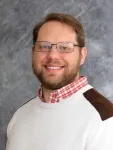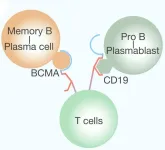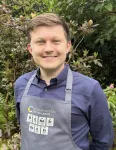(Press-News.org) Supermassive black holes pose unanswered questions for astronomers around the world, not least “How do they grow so big?” Now, an international team of astronomers, including researchers from Chalmers University of Technology in Sweden, has discovered a powerful rotating, magnetic wind that they believe is helping a galaxy’s central supermassive black hole to grow. The swirling wind, revealed with the help of the ALMA telescope in nearby galaxy ESO320-G030, suggests that similar processes are involved both in black hole growth and the birth of stars.
Most galaxies, including our own Milky Way have a supermassive black hole at their centre. How these mind-bogglingly massive objects grow to weigh as much as millions or billions of stars is a long-standing question for astronomers.
In search of clues to this mystery, a team of scientists led by Mark Gorski (Northwestern University and Chalmers) and Susanne Aalto (Chalmers) chose to study the relatively nearby galaxy ESO320-G030, only 120 million light years distant. It’s a very active galaxy, forming stars ten times as fast as in our own galaxy.
“Since this galaxy is very luminous in the infrared, telescopes can resolve striking details in its centre. We wanted to measure light from molecules carried by winds from the galaxy’s core, hoping to trace how the winds are launched by a growing, or soon to be growing, supermassive black hole. By using ALMA, we were able to study light from behind thick layers of dust and gas”, says Susanne Aalto, Professor of Radio Astronomy at Chalmers University of Technology.
To zero in on dense gas from as close as possible to the central black hole, the scientists studied light from molecules of hydrogen cyanide (HCN). Thanks to ALMA’s ability to image fine details and trace movements in the gas – using the Doppler effect – they discovered patterns that suggest the presence of a magnetised, rotating wind.
While other winds and jets in the centre of galaxies push material away from the supermassive black hole, the newly discovered wind adds another process, that can instead feed the black hole and help it grow.
“We can see how the winds form a spiralling structure, billowing out from the galaxy’s centre. When we measured the rotation, mass, and velocity of the material flowing outwards, we were surprised to find that we could rule out many explanations for the power of the wind, star formation for example. Instead, the flow outwards may be powered by the inflow of gas and seems to be held together by magnetic fields”, says Susanne Aalto.
The scientists think that the rotating magnetic wind helps the black hole to grow.
Material travels around the black hole before it can fall in – like water around a drain. Matter that approaches the black hole collects in a chaotic, spinning disk. There, magnetic fields develop and get stronger. The magnetic fields help lift matter away from the galaxy, creating the spiralling wind. Losing matter to this wind also slows the spinning disk – that means that matter can flow more easily into the black hole, turning a trickle into a stream.
For Mark Gorski, the way this happens is strikingly reminiscent of a much smaller-scale environment in space: the swirls of gas and dust that lead up to the birth of new stars and planets.
“It is well-established that stars in the first stages of their evolution grow with the help of rotating winds – accelerated by magnetic fields, just like the wind in this galaxy. Our observations show that supermassive black holes and tiny stars can grow by similar processes, but on very different scales”, says Mark Gorski.
Could this discovery be a clue to solving the mystery of how supermassive black holes grow? In the future, Mark Gorski, Susanne Aalto and their colleagues want to study other galaxies which may harbour hidden spiralling outflows in their centres.
“Far from all questions about this process are answered. In our observations we see clear evidence of a rotating wind that helps regulate the growth of the galaxy’s central black hole. Now that we know what to look for, the next step is to find out how common a phenomenon this is. And if this is a stage which all galaxies with supermassive black holes go through, what happens to them next?”, asks Mark Gorski.
More about the ALMA telescope:
The Atacama Large Millimeter/submillimeter Array (ALMA), an international astronomy facility, is a partnership of ESO, the U.S. National Science Foundation (NSF) and the National Institutes of Natural Sciences (NINS) of Japan in cooperation with the Republic of Chile. ALMA is funded by ESO on behalf of its Member States, by NSF in cooperation with the National Research Council of Canada (NRC) and the National Science and Technology Council (NSTC) in Taiwan and by NINS in cooperation with the Academia Sinica (AS) in Taiwan and the Korea Astronomy and Space Science Institute (KASI).
ALMA construction and operations are led by ESO on behalf of its Member States; by the National Radio Astronomy Observatory (NRAO), managed by Associated Universities, Inc. (AUI), on behalf of North America; and by the National Astronomical Observatory of Japan (NAOJ) on behalf of East Asia. The Joint ALMA Observatory (JAO) provides the unified leadership and management of the construction, commissioning and operation of ALMA.
Chalmers University of Technology and Onsala Space Observatory have been involved in ALMA since its inception; receivers for the telescope are one of many contributions. Onsala Space Observatory is host to the Nordic Alma Regional Centre, which provides technical expertise to the Alma project and supports astronomers in the Nordic countries in using Alma.
More about the research:
The research is presented in the paper: "A spectacular galactic scale magnetohydrodynamic powered wind in ESO 320-G030", published in the journal Astronomy and Astrophysics.
The researchers involved in the study are Mark Gorski, Susanne Aalto, Sabine König, Clare F. Wethers, Chentao Yang, Sebastien Muller, Kyoko Onishi, Mamiko Sato, Niklas Falstad, J. G. Mangum, S. T. Linden, F. Combes, S. Martín, M. Imanishi, K. Wada, L. Barcos-Muñoz, F. Stanley, S. García-Burillo, P. P. van der Werf, A. S. Evans, C. Henkel, S. Viti, N. Harada, T. Díaz-Santos, J. S. Gallagher and E. González-Alfonso.
At the time of the study the researchers were active at: Chalmers University of Technology, Sweden; National Radio Astronomy Observatory, USA; University of Massachusetts at Amherst, USA; PSL University, France; European Southern Observatory, Chile; National Astronomical Observatory of Japan; Kagoshima University, Japan; University of Virginia, USA; Institut de Radioastronomie Millimétrique (IRAM), France; Observatorio Astronómico Nacional (OAN-IGN), Spain; Leiden University, The Netherlands; Max-Planck-Institut für Radioastronomie, Germany; Chinese Academy of Sciences, PR China; King Abdulaziz University, Saudi Arabia; University College London, UK; Graduate Institute for Advanced Studies, Japan; Foundation for Research and Technology-Hellas (FORTH), Greece; European University Cyprus, University of Wisconsin, USA; Universidad de Alcalá, Spain; Northwestern University, USA.
For more information, please contact:
Mark Gorski, Department of Space, Earth and Environment, Chalmers University of Technology, Sweden; and Northwestern University, USA mark.gorski@northwestern.edu +1 847 467 1338 \+1 847 491 8646
Susanne Aalto, Professor, Department of Space, Earth and Environment, Chalmers University of Technology, Sweden, susanne.aalto@chalmers.se +46 31 772 66 93
The contact persons speak English and are available for live and pre-recorded interviews. Susanne Aalto also speaks Swedish. At Chalmers, we have podcast studios and broadcast filming equipment on site and would be able to assist a request for a television, radio or podcast interview.
END
Supermassive black hole appears to grow like a baby star
2024-06-20
ELSE PRESS RELEASES FROM THIS DATE:
Early detection crucial in bile duct cancer for patients with rare liver disease
2024-06-20
Primary sclerosing cholangitis (PSC) is a rare progressive liver disease that damages bile ducts and significantly increases the risk of bile duct cancer, particularly a type called cholangiocarcinoma (CCA). This cancer is aggressive, and curative surgery is uncommon. Liver transplantation is a potential treatment option for some PSC-CCA patients, especially if the cancer is caught early. Early diagnosis is essential for successful treatment.
PSC can affect people of all ages but primarily strikes men in their 30s and 40s. It is often accompanied by inflammatory bowel disease (IBD). The disease can progress to liver failure and increase the risk of colorectal cancer ...
BCMA-CD19 bispecific CAR-T therapy in refractory chronic inflammatory demyelinating polyneuropathy
2024-06-20
This study is led by Professor Junnian Zheng and Ming Shi from the Cancer Institute of Xuzhou Medical University, together with the team of Professor Guiyun Cui and Wei Zhang from the Affiliated Hospital of Xuzhou Medical University. The team reported for the first time using BCMA-CD19 bispecific CAR T cells for treating relapsed/refractory CIDP.
Chronic Inflammatory Demyelinating Polyneuropathy (CIDP) is an uncommon condition with sudden onset symptoms, including nerve damage affecting movement, sensation, speech, breathing, and heart rate. ...
Embryo and organoid models do not threaten the definition of personhood, bioethicist says
2024-06-20
Advances in organoids and embryonic models of human development have the potential to prompt social and existential questions—e.g., what defines human individuality? However, bioethicist Insoo Hyun of Harvard Medical School and the Museum of Science in Boston says that these models have the potential to strengthen rather than weaken the concept of human individuality when considered within the philosophical frameworks of “personhood” and sentience. In a commentary publishing June 20 in the journal Cell, Hyun argues that despite huge advances, we are a long way off from developing technologies that would ...
Great British Bake Off finalist Josh Smalley discusses the parallels between chemistry and baking
2024-06-20
Last year on a Friday evening, chemical biology researcher Josh Smalley was in the lab when he received a call inviting him to appear on the 14th and latest season of The Great British Bake Off. Starting as one of a group of 12 amateur bakers, Smalley made it all the way to the final round, where the top 3 contestants compete for the winning spot. In an essay published in the journal Cell Chemical Biology on June 20, Smalley describes the overlap between chemistry and baking and how his training in one ...
New genetic cause of obesity could help guide treatment
2024-06-20
Scientists have discovered a new cause of why people who lack a specific blood group are genetically predisposed to be overweight or obese.
A team of international researchers, led by the University of Exeter, discovered that people with a genetic variant that disables the SMIM1 gene have higher body weight because they expend less energy when at rest.
SMIM1 was only identified 10 years ago, whilst searching for the gene encoding a specific blood group, known as Vel. One in 5,000 people lack both copies of the gene, making them Vel-negative. The findings from the new research suggest that this group is also more likely to be overweight, a conclusion ...
Palaeontology: New, small, ancient crocodile-like reptile described in Brazil
2024-06-20
The discovery of a new, ancient, predatory reptile dubbed Parvosuchus aurelioi — part of a group of crocodile-like reptiles called pseudosuchians — in Brazil is described in a paper in Scientific Reports. The specimen, which dates to approximately 237 million years ago, during the Middle-Late Triassic, is the first small predatory reptile of its kind to be found in this country.
Prior to the dominance of the dinosaurs, pseudosuchians were a common form of ancient quadruped reptile during the Triassic Period (252 – 201 million years ago), with some species amongst ...
Prenatal maternal psychological distress during the pandemic and newborn brain development
2024-06-20
About The Study: The findings of this study suggest that increased maternal mental health symptoms during the COVID-19 pandemic are associated with subsequent changes in regional brain growth in newborn offspring.
Corresponding Author: To contact the corresponding author, Nickie Andescavage, M.D., email nniforat@childrensnational.org.
To access the embargoed study: Visit our For The Media website at this link https://media.jamanetwork.com/
(doi:10.1001/jamanetworkopen.2024.17924)
Editor’s Note: Please see the article for additional information, including ...
Healthy lifestyle and the likelihood of becoming a centenarian
2024-06-20
About The Study: In this case-control study of Chinese older adults, adhering to a healthy lifestyle appears to be important even at late ages, suggesting that constructing strategic plans to improve lifestyle behaviors among all older adults may play a key role in promoting healthy aging and longevity.
Corresponding Authors: To contact the corresponding authors, email Xiang Gao, M.D., Ph.D. (xiang_gao@fudan.edu.cn) and Xiaoming Shi, M.D., Ph.D. (shixm@chinacdc.cn).
To access the embargoed study: Visit our For The Media website at this link https://media.jamanetwork.com/
(doi:10.1001/jamanetworkopen.2024.17931)
Editor’s Note: Please see ...
New, simple test detects rare fatal genetic heart condition
2024-06-20
A team of international researchers has revealed a new, simple clinical test to detect Calcium Release Deficiency Syndrome (CRDS), a life-threatening genetic arrhythmia that causes dangerously fast heartbeats and can lead to severe complications such as sudden cardiac arrest and death.
The new diagnostic method monitors for changes in electrocardiography (ECG) after a brief period of a fast heartbeat and a pause, which can occur naturally or be induced by artificially pacing the heart.
This research was co-led by Jason Roberts, a scientist at the Population ...
YALE NEWS: Chemotherapy before surgery benefits some patients with pancreatic cancer
2024-06-20
New Haven, Conn. — Patients with pancreatic cancer who received chemotherapy both before and after surgery experienced longer survival rates than would be expected from surgery followed by chemotherapy, according to a new study from researchers at Yale Cancer Center (YCC) and Yale School of Medicine.
The study, published June 20 in JAMA Oncology, included patients with pancreatic ductal adenocarcinoma (PDAC), which accounts for 90% of pancreatic cancers. An aggressive cancer with a high mortality rate, PDAC is predicted ...





